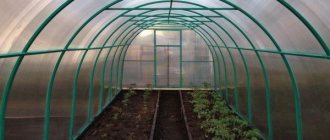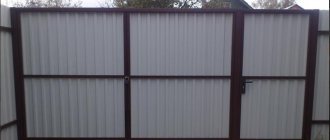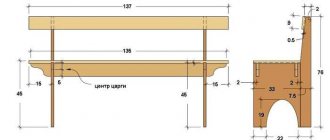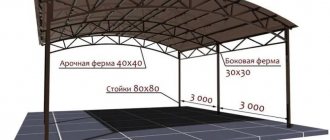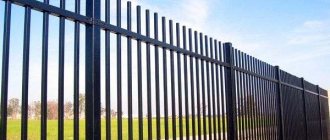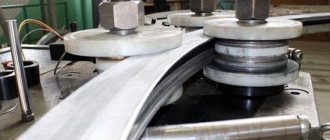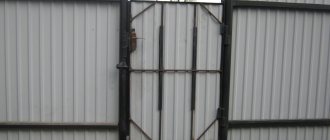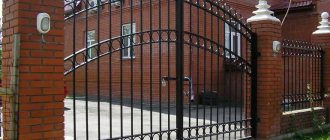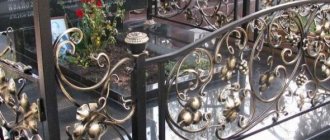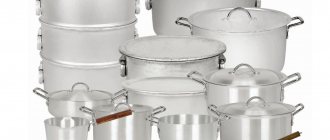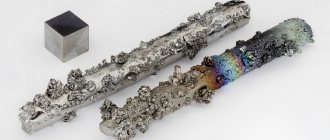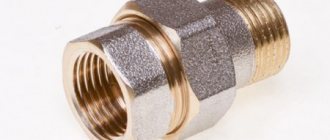There are many applications for profile pipes. Most often they are used to create load-bearing structures. Depending on the individual qualities that the profile pipe has, the products are used for the construction of markets, stadiums, pavilions, roofs and other structures.
An aluminum profile pipe with a rectangular cross-section is a product that is hollow in cross-section and has the shape of a rectangle. This is a modern building material offered by metallurgists in the non-ferrous industry.
Back in the last century, they began to produce profile aluminum pipes. However, aluminum profile pipes became truly widely used about ten years ago.
About rolled metal and metal products
Metal products are of leading importance in the construction and decoration of civil buildings and industrial facilities.
Metal products in the decoration and renovation of premises are metal profiles for the frame, as well as rolled metal in the form of round and square pipes. Rolled metal in construction is more diverse. These are fittings, angles, channels, metal wire, various sheets, I-beams. Transportation of rolled metal is quite expensive and a large selection of rolled metal from the seller is important for reducing costs and comprehensively completing the facility. If you need rolled metal, pay attention to an operator on the rolled metal market in the Dnieper region.
About plasterboard structures
All plasterboard structures are built from four main types of profiles: rack and guide profiles for plasterboard partitions and guides and ceiling profiles for plasterboard ceilings.
In cross-section, the profiles for gypsum craton are shaped like the letter P; accordingly, the profiles have one wall and two shelves. The guide profiles, both for ceilings and partitions, have even shelves. In rack and load-bearing ceiling profiles, the profile flanges have bends to strengthen the structure.
Profiles are connected in two ways:
- Using a special tool called a cutter;
- Using metal-to-metal screws. Self-tapping screws are marked as LN, these are piercing screws and LB drilling screws.
In terms of construction, plasterboard profiles are a technologically advanced material and can be connected in very different ways. Some connection methods can be classified as standard, and they are indicated in the technological maps of profile manufacturers. The second part of the connection methods can be called non-standard.
Screw connections
Types of screw connections
Screw connections are classified as detachable connections. By design they can be (Figure 1):
- through, protruding from both sides;
- through, protruding from one side;
- not through (blind), protruding from one side.
Figure 1 – Structural types of screw connections [1]
If appropriate measures are taken against corrosion, screw connections are perfectly suitable for components made of sheet aluminum and aluminum profiles:
- Fastening elements must be made of corrosion-resistant stainless steel (steel group A2/A4).
- Since aluminum alloys have relatively low compressive strength, the contact surfaces must be protected by using washers under both the screw head and the nut.
Types of screw connections for thin sheets
In addition to screw-nut joining methods, thin sheets can be joined together using a wide variety of threaded fasteners (Figure 2).
Figure 2 - Different types of screw connections for thin sheets [2]
With the help of fasteners of the “screw-nut” type, high fastening forces are provided. On the other hand, special screws for thin-walled parts are used to eliminate the drilling operation during final assembly, since these screws cut a hole for themselves.
Working principle of self-tapping screws
The disadvantage of most thin-walled joints is the very limited length of screw that can carry the load. The situation can be improved by forming a cylindrical collar around the hole, which is what happens when installing a self-tapping screw. The carbide tip of a self-tapping screw, which has no threads, acts like a cone punch that rotates at high speed and punches right through the metal. As a result of plastic deformation of the sheet metal, a massive bead is formed around the hole. Then a self-tapping screw cuts a thread in this hole and makes a screw connection (Figure 3).
Figure 3 – Principle of installation of a self-tapping screw [1]
Screw connections for aluminum profiles
To connect parts made of aluminum alloys, screws made of corrosion-resistant stainless steel with a head that is adapted for fastening sheet materials are most often used. Aluminum profiles for connecting to each other or to sheet materials can have longitudinal and transverse screw channels (or grooves) (Figure 4).
Figure 4 – Screw connections for aluminum profiles [1]
How to connect drywall profiles standard and non-standard
By standard methods we mean connecting profiles using specially produced connecting elements and techniques recommended by drywall manufacturers (Knauf, Giprok). We will call all other methods of connecting profiles non-standard and the technique of such connections depends only on the imagination of the installer.
In this article we will consider the following types of profile connections:
- Extension of profiles (overlapping and butt);
- Connecting profiles in the corner of structures;
- T- and X-shaped connections of profiles.
Extension of profiles
When installing large structures, it is necessary to connect both ceiling and rack profiles. When extending, the profiles can be joined end-to-end or overlapped. For butt connections, special standard connectors are used. They are applied to the butt joint of the profiles and secured with self-tapping screws.
To connect rack profiles, instead of standard connectors, you can use a piece of rack profile (PS). It is also applied to the butt joint of the profiles and secured with self-tapping screws. With such a connection, it is important to maintain the length of the applied profile.
| Profile brand | Overlay profile length |
| PS 50 | from 500 mm |
| PS 75 | from 750 mm |
| PS 100 | from 100 mm |
Technology No. 1 – use of special elements
Modern manufacturers produce a range of components for mounting metal profile frames. Special connections for drywall profiles can have different configurations, I will tell you about the most popular and convenient ones. The information is presented in table form to help you understand it better.
Connectors can have different configurations
| product name | Purpose and design features |
| Profile extension | It is used to lengthen the main (60x27) profile and is a special insert that accurately aligns the elements with each other and strengthens the junction. The products are made of galvanized metal, the thickness of which must be at least 0.9 mm; for ease of alignment, there may be a special protrusion in the middle into which the ends of the profile rest. |
| Single-level connector “Crab” | It is this one that is shown in the photo above; this option is used to connect the main profile in one plane. The design is such that installation is quick and reliable; you do not need to perfectly fit the elements, they are simply inserted into the crab and fixed with self-tapping screws. Products must be quite rigid, because they are subject to considerable load |
| Two-level connector | If you need to connect two profiles that are located one below the other, then this element will be the best solution. With its help, the structure is quickly assembled and high reliability of fixation is achieved. Such options are rarely used in private development, however, their convenience is undeniable |
| Side connector | And this type of product is completely unfamiliar to our developers. But with its help, making T-shaped connections is much easier and faster, so I recommend using such connectors if you need to fasten two perpendicular profiles |
To accurately calculate the required amount of fasteners, the easiest way is to make a sketch of the future frame and draw all its elements. This makes it much easier to figure out how much and what kind of fasteners you need, and you don’t have to travel several times to buy additional products or think about how to return the remaining parts to the seller.
The two-level connector is ideal for assembling oval structures and for suspended ceiling systems
Necessary materials and equipment
Now let’s figure out how to properly connect a drywall profile using all the products described above.
In addition to the fasteners themselves, we will need additional materials and tools:
- Self-tapping screws for fastening, in one of the previous reviews I spoke in detail about the main types and their features. Here I will only give a recommendation to use bugs (as experts call small self-tapping screws) with a sharp tip 9 or 11 mm long; the coating can be anything, this does not affect the quality of the product. As for the quantity, the norm is 20-25 pieces per square meter of structure, in fact it usually turns out that way ;
These screws are ideal for our purposes.
- The screws are tightened using a screwdriver with a special attachment. All hardware used when installing drywall has a head for the PH2 slot, so buy several bits of this size, they may differ in length, it is most convenient for me to work with equipment 50 mm long, and for hard-to-reach places you may need a longer version;
I recommend using a double-sided socket PH2, it is not much more expensive, but it replaces two bits at once
- When connecting profiles, they most often need to be cut, so make sure you have metal scissors on hand in advance. The simplest option will do, as long as the tool is sharp.
Installation of extension cords
The instructions for carrying out the work are different for each type of fastener; we will analyze these options separately and start by considering how to lengthen the rack profile for drywall:
- When extending racks, strength and geometric accuracy are of particular importance, which is why be sure to use extensions . If there are several options on sale, then choose the one that is made of thicker metal and has protrusions on the sides. Thanks to them, the profile will connect exactly in the middle of the fastener;
The connector must be rigid
- First of all, you need to take measurements to determine the length of the elements to be fastened. Next, cutting is carried out; for this, the profile is marked using a tape measure and a felt-tip pen, after which the product is cut with metal scissors. Subtract 10-15 mm from the total length of the element that should be obtained to simplify further work;
- Now let's figure out how to lengthen the profile: first, the connector is inserted into the end of one of the profiles, after which a second piece is placed on the other side. The knot must fit tightly; if it dangles, the strength will suffer greatly. When you are sure that the stand is level, you need to fix the connection; screw in two self-tapping screws on each side to ensure maximum reliability;
Thanks to the connector, we get a perfectly flat long stand
Mounting crabs
We figured out how to build up the profile, now we’ll look at how to attach jumpers to the rack using a crab, the technology for doing the work yourself is as follows:
- First of all, it is necessary to take measurements in order to determine the length of all fastened elements. In this case, the size of the crossbars should be 5 mm less than the total length, this is necessary so that they fit normally in the structure and do not deform in it;
- The connector is inserted into the main rack from the reverse side; this is done simply, because the product is adjusted to the dimensions of the profile . It is important to position it at the desired level and snap it all the way so that the element fits as tightly as possible;
Spacer antennae reliably fix the unit in the profile, simplifying the installation process
- Then a jumper is inserted on one side, this is done simply: the profile is placed on the side and snaps onto the mount; if necessary, it needs to be moved closer to the rack so that the gap between the elements is minimal;
The side element is inserted into the fixing antennae, after which the side elements can be bent
- There are protrusions with holes on each side; they are bent along the profile, after which self-tapping screws are screwed into them. Everything is quite simple and quick, so after attaching one crab you will be well versed in this type of work;
It is convenient to attach the connection, as it holds without outside help
- The second side is fixed in the same way. If you use a crab to attach the jumper on one side, then the second part can simply be cut off with metal scissors.
Installation of two-level connectors
A two-level connector is necessary in cases where you need to connect two main profiles located below each other or assemble a complex structure.
The element itself is a holder, in the lower part of which there are protrusions that fit into the grooves of the profile; they are the ones that hold the racks; no additional fasteners are used. In the upper part there are clamps that snap into the protrusions of the sides of the upper profile and prevent the unit from moving.
This is what a two-level profile connector looks like
The installation process is quite simple:
- The connector is inserted into the upper profile in the required place, it fits exactly in size, so it will hold tight;
- The lower profile must be inserted so that the protrusions fit into the bends of the sides, due to this the structure will hold, so it is worth checking each connection for reliability, whether everything is located as it should be . If desired, the fasteners can be attached to the top profile through the holes in the connector.
This is what a two-level connector looks like in the design
Installation of side connectors
This type of fastener is ideal for attaching lintels to a ceiling frame on one side. Most often it is used in multi-level ceiling systems and at frame junctions with walls. The connector is a product that is inserted into the end of the profile with one side, and the other clings to the side of the profile located perpendicularly.
The connector provides quick and reliable fastening of the crossbars to the rack
Let's figure out how to use this element:
- First of all, it is necessary to take measurements in order to cut off pieces of the profile of the required length; they should be 5 mm less than the total distance;
- The fastener is inserted all the way into the end of the profile that we will attach; sometimes, in order to do this, it is necessary to apply considerable force;
- Next, the prepared element is simply hung on the side of the rack; an indication that you have done everything correctly is the even position of the profiles relative to each other . There is a protrusion on the hook that extends beyond the bend of the side and thus secures the mount;
This is how easy this part of the work is done
- If desired, you can screw several self-tapping screws into the sides through the profile and connector and into the end of the rack through the hole in the fastener. This will prevent the unit from disconnecting under load.
Connecting profiles in the corner of the structure
When installing frames for a box or cabinet made of plasterboard, the task arises of connecting the guides and rack profiles at the corner of the structure.
If only rack profiles are used for the frame, they are easily inserted into each other and connected to each other with self-tapping screws (photo 1) or a cutter (photo 2) in three places (top, middle and bottom).
Small plasterboard structures such as pipe boxes or battery screens can be mounted entirely from guide profiles (PN 50×27). Two guide profiles are connected in the corner in the same way as rack-mount ones, only the curved edges of the shelves are cut off for one profile. I repeat, profiles for plasterboard are quite technologically advanced and you can use your imagination in connecting profiles. The main thing is that the resulting structure is strong and stable.
Aluminum profile pipes in industry
Aluminum profile pipes are widely used in the aircraft industry due to their low weight. Aluminum profiles are also used in shipbuilding and automotive industry.
Aluminum pipes have a very smooth inner surface, which allows liquids to flow through them perfectly. In addition, aluminum profile pipe is actively used in the chemical industry, since the material is not susceptible to corrosion and active environments.
When aluminum is exposed to oxygen, a film is formed on the surface of the pipes, which protects the product from external influences. Aluminum pipe is widely used in air conditioning and refrigeration systems.
In domestic conditions, profiled aluminum pipe is used to create furniture and decorative elements. The fact is that this building material is quite expensive. However, stairs, railings, sports equipment and fences can often be made using aluminum profile pipes.
Aluminum pipe goes well with other building materials. Everyone knows how beautiful a door made using an aluminum profile looks.
Aluminum is not a very strong material. Therefore, copper and magnesium are added to the alloy when making pipes. This results in a durable and flexible material. One of the most common alloys is duralumin. This is a hard and at the same time light alloy. Modern aircraft are approximately 70 percent aluminum. It gives the structure lightness and strength.
Since duralumin is more susceptible to corrosion, a layer of pure aluminum is applied to the surface of parts consisting of this alloy. Once the finished product undergoes heat treatment, it is sent to various factories.
How to connect profiles for plasterboard ceilings
Profiles for plasterboard ceilings in frame structures have to be extended and connected at an angle of 90°. Extension of PP ceiling profiles (60x27) is carried out using special extensions.
Cross-connection of ceiling profiles is made using special connectors. The connection of ceiling profiles in a single-level ceiling is made with a single-level connector for ceiling profiles PP 60/27, simply called “crab”.
The connection of profiles in a two-level ceiling is made with a two-level connector. It can be rotated along its axis to the desired connection angle.
• We weld aluminum without welding (using the example of a car trunk)
Using a propane torch from a hand torch and an aluminum rod, we firmly fasten the aluminum without the use of a welder. This makes for a very strong connection and with a little practice can be done quickly with great looking results. But how?
We take a manual gas torch:
You also need aluminum rods (strips, wire - whatever you have)
cutting blanks
processing
clean with an iron brush (this is especially important!)
heat for 4-5 minutes
Rub the hot edges quickly with an aluminum stick (or whatever you have)
Unclear? then this video is for you:
